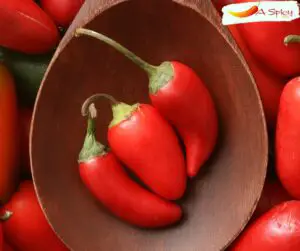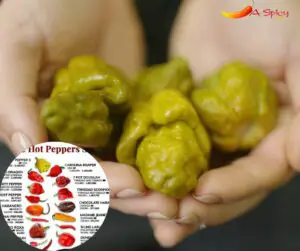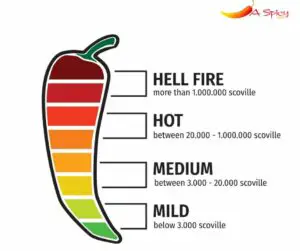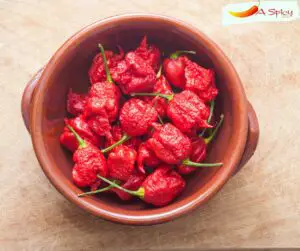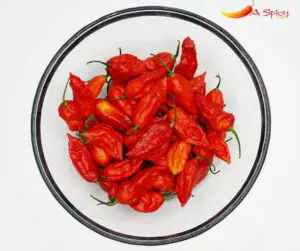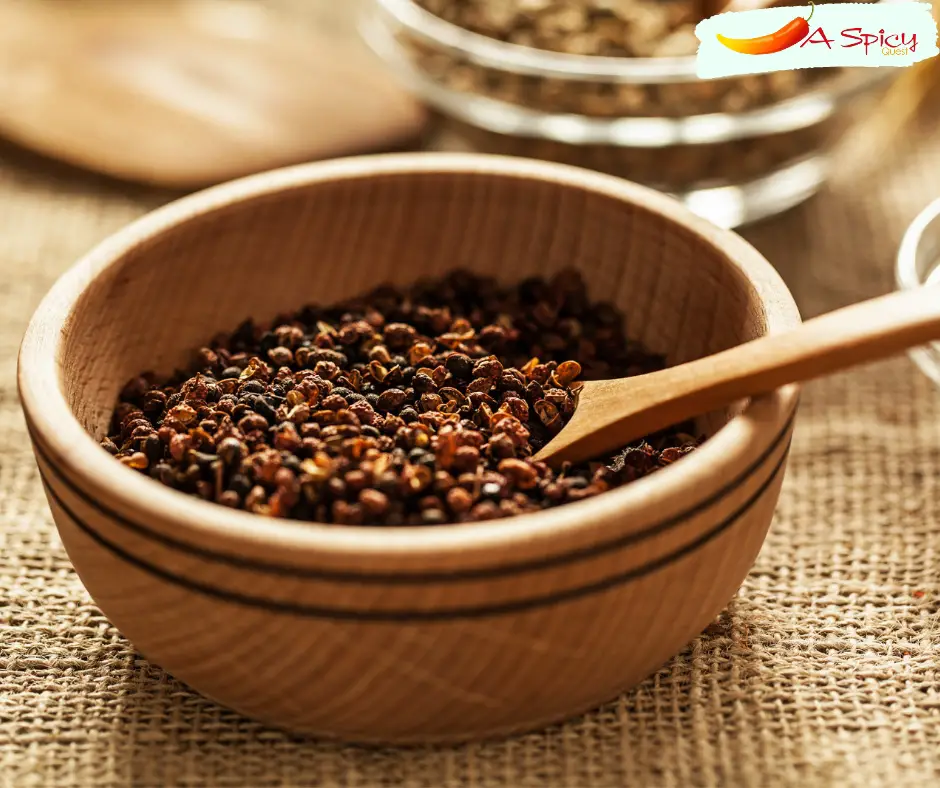
When it comes to making the perfect dishes, peppers are a must-add. Peppers are members of the capsicum family, and their seeds are known as pips. They come in several sizes, shapes, and spicy levels. And one famous pepper is the Szechuan pepper. But precisely what is the Scoville scale for Szechuan pepper?
What Is the Scoville Scale for Szechuan pepper?
Spicy Szechuan peppercorns measure between 50,000 to 75,000 Scoville heat units. They’re also known as Chinese coriander and hua jiao. Szechuan pepper is a spice similar to black peppercorn but has a milder flavor.
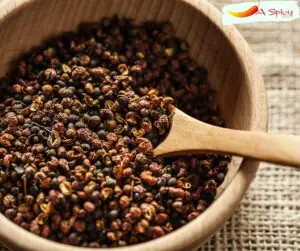
It’s not related to the chili pepper family, though you’ll find them in many of the same dishes. It adds heat and flavor to Asian cuisine and is often used with meat such as duck, chicken, or pork. It can also be used with vegetables like broccoli or cauliflower.
Szechuan pepper is not a single spice but an umbrella term for several varieties of the plant Zanthoxylum bungeanum commonly used as spices. The most popular Szechuan peppers are made from the dried fruit of the Szechuan pepper tree. The most common forms used in cooking include Zanthoxylum simulans and Zanthoxylum bungeanum.
What You Should Know About the Szechuan Pepper
The Szechuan pepper, also known as the prickly ash and Chinese coriander, is a perennial shrub native to eastern Asia. It is cultivated commercially in China, Korea, India, and Indonesia but can also be found growing wild across the eastern half of Asia.
The herbaceous plant produces small greenish-white flowers that produce dark red berries that mature into pungent orange-red fruits when dried. This peppercorn has been used for centuries in Chinese medicine as a digestive aid and has been increasingly popularized over recent years by chefs experimenting with new cuisines from around the world.
Sichuan peppers are usable either fresh or dried and whether they are fully matured red stage or at an early green stage. They are used as flavoring and heat in many dishes from all over Asia, such as chow mein noodles from Singapore, Thai curries, and Indonesian sambal relishes.
What Does Szechuan Pepper Taste Like?
Szechuan pepper has a citrus-like flavor and induces a tingling numbness, similar to having a 50Hz vibration in your mouth. Its numbing sensation is a result of the unique combination of particular chemical compositions, namely hydroxy-alpha sanshool and capsaicin.
Sichuan pepper is well-known for its hot and spicy flavor with sweetness and sourness altering flavors. The mouth tingle enhances the taste of other ingredients in your food, making them equally pronounced.
Why You Should Szechuan Pepper to Your Meal?
The Scoville Scale or Scoville Heat Units (SHU) is a measure of the pungency (spiciness) of chili peppers. And now that you know the power of the Szechuan pepper, here are some reasons for you to consider adding them to your meals:
Excellent Source of Vitamins
Szechuan pepper is a good source of vitamins A, B, C, and E. Vitamin C helps to maintain healthy skin and gums. Vitamin A is an essential antioxidant that helps fight free radicals, which can cause damage to cells in the body.
It also contains vitamins B6 and K, folate, potassium, and fiber, aiding in weight loss. The presence of amino acids can also help build protein and manganese, a mineral that plays a role in energy metabolism.
Great for Stimulating Fluid Circulation
Szechuan pepper is a warming spice that stimulates circulation. Consuming Sichuan pepper in its original form can help increase the hemoglobin content in your blood. This, in turn, can help promote the circulatory system due to its richness in a high amount of iron.
This makes it an excellent option for anyone suffering from anemia. Additionally, Szechuan pepper can also function as an analgesic. The chemicals present in it can inhibit your body’s pain receptors, thereby eliminating the sensations of discomfort and pain.
Increases Appetite
Aides from using Szechuan pepper can add flavor to food; it can also help you stimulate your appetite. This pepper holds abundant nutrients that kick-start the appetite and improve the speed of metabolism.
And if you are recovering from any major illness, Szechuan pepper is perfect for your meal. That way, you can derive the nutrients from the food and heal faster.
Improves Immunity
Szechuan pepper is known for its antioxidant properties earlier mentioned. However, if you don’t know, you can rely on this pepper to help you boost your immune system. It also has a strong correlation with being able to help the body resist certain diseases such as cancer, diabetes, and heart disease. A potent mineral essential for improving the immunity of the body.
In traditional Chinese medicine, it’s used to treat several ailments, including promoting healthy digestion. It’s also an anti-inflammatory pain reliever that can promote digestive health by relieving constipation or diarrhea.
Eliminate Inflammation
Inflammation is the body’s response to injury or infection. It can also signify an underlying medical condition such as arthritis or cancer; it affects joints, skin, and the digestive tract. The compound found in Szechuan pepper neutralizes the free radicals and arrests the inflammation even before it starts.
The terpene profile found in this spice contains various antioxidants, including phytosterols and terpenes. These compounds provide natural anti-inflammatory attributes that help reduce inflammation in your body.
Help Reduce Blood Pressure
Szechuan pepper is a good source of potassium and calcium, which are essential for maintaining your body’s fluid balance. These minerals can help lower blood pressure, improve cardiovascular health and even reduce cancer risk. It relaxes the blood vessels preventing high blood pressure, and lowers the potential effect of cholesterol. Thus, preventing heart attacks and strokes.
Uses of Szechuan Pepper
Szechuan pepper is used in Chinese cuisine, Japanese and Korean cooking, and Indian, Middle Eastern, and Mexican cuisines. It is also used in the making of Worcestershire sauce. Szechuan peppercorns are a fragrant, mouth-numbing spice in several Sichuan dishes like Dan-Dan noodles and Szechuan chicken.
They are more popular in cooked applications such as frying, boiling, sautéing, or stir-frying fresh ingredients. Fresh Sichuan peppers can be used to make chili pastes, oils, or sauces that can be added to cooked meats, vegetables, rice, and noodle dishes.
Is Szechuan Hotter Than Jalapeno Pepper?
The SHU rating of a jalapeño pepper ranges from 2500 to 8000, while the Scoville heat units (SHU) of Szechuan peppers range from 50,000 to 75,000. This shows that the Szechuan pepper is hotter than your average jalapeño.
Conclusion
Szechuan pepper is a super-hot pepper native to China. This pepper is most commonly used in Asian cuisine, including Chinese and Thai food. They can be found whole or ground into powder form. The Scoville scale measures show the hotness of the Szechuan pepper to be around the range between 50,000 – 75,000 Scoville units.

